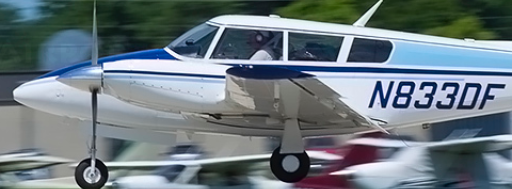I’ve gotten my processes down on the Cheyenne flying with Jeff these past two weeks, so I decided to fly my own Twin Comanche yesterday. I invited Jeff along so he can experiment with the IFD550 he has in his Cessna 310.
Landings in the Cheyenne are where I want them to be in every respect, so now I’d like to be sure I haven’t lost anything in my Twin Comanche techniques. We decided to take mine out even though the winds yesterday were 18 gusting 30. I expected to see difficult turbulence, so I warned Jeff and we decided to take off and see how it was. The turbulence wasn’t too bad above 3000′, so we headed on south to Delaware Coastal for a few approaches.
I had loaded my updated chart data a day early in my airplane, versus the last flight we did had done with expired charts in the Cheyenne. With outdated charts, the Garmin GTN750 won’t provide vertical guidance on an LPV, so you lose significant capability if your databases go out of date on a trip. Navigation still works, but you’ll be limited to VOR, LOC, or ILS approaches.
Based on that experience, I was worried about the fact that I loaded my IFD550 approach plates a day early for this flight. I might not get a glidepath on the RNAV22 approach into Delaware Coastal since my charts weren’t current for that day. We worked out a plan to fly the visual approach with vertical guidance if that were the case, but as it turned out, the LPV worked out. We flew the approach through to the missed in visual conditions.
I demonstrated how the autopilot in my airplane held the glidepath through a significant gusting crosswind all the way down to minimums. Not too shabby for a 1965 design on the Altimatic IIIb. Kudos Mr Jim Good up at Lancaster Avionics for his patience and experience in getting this thing working again.
Heading back north again, you can see a westerly jaunt on the inset flightpath above. Jeff wanted to get a look at where my house is situated on the C&D canal, so we did a fly by there before heading back to Wilmington. We were able to find the house quickly using our new Pergola’s metal roof. It looks like a big silver ‘L’ from the air.
Avionics Differences: Part of what I’m trying to do here is to change my processes as little as possible, and come up with a set of common procedures that work in both airplanes.
The Cheyenne has a Garmin suite that includes the G600Txi PFD, GTN750, the old school Garmin 530 WAAS, and an Aspen PFD for the copilot. My Twin has the Aspen ProMax centerpeice with the analog displays surrounding it, an IFD550, a Garmin GNC215 as #2, and a GPS496 I use for Sirius Wx and flight plan waypoint distances. The autopilots in each airplane are originals, so I know how to talk to the old stuff and make it work. Both airplanes have dual weather sources and traffic.
Preferences: I never really liked the GTN750 user interface and implementation during IFR operations. I still don’t, but at least now I can use it effectively. Looking at the GTN units when considering a Garmin 530W radio upgrade led me in a different direction to an Avidyne radio. I chose the Avidyne IFD550, but I did have some challenges getting used to it. I do not like how the Avidyne updates, and it has burned me once already. While I am pretty good at operating it now, I needed to ensure that going back and forth between the two systems wouldn’t present any new challenges.
CRM: I only have about 8 hours in the Cheyenne with it’s Garmin suite, including the checkout training, as I write this. I am able to program the radios without too much fuss, but now I’m doing all this with a second pilot onboard. Jeff and I have been working together to help me understand the processes he has been using with others in this airplane, so that I can get what I need during IFR flights while keeping him productive and comfortable. It is a process of negotiation and understanding; ending up with an expectation we’ll share if and when I fly right seat for him. Both of us are Gulfstream trained and have common processes to start with, so this shouldn’t be too hard.
Holds: While Jeff and I are out practicing, I added one unusual procedure to the flight plan today. Programming HOLDS in the two machines is only challenging because you don’t do it often; when you get one you are often surprised; and the Garmin and Avidyne processes are somewhat different. Impromptu holds are something that is not often done, using either radio, so we have to practice them often to keep them in memory. We reviewed doing holds on the iPad simulators first, and then in my airplane for the most recent flight. I’ll do one for practice in the Cheyenne soon.
Stress Testing: I believe in planning for the worst and training for that. This means developing the capability to fly an approach to minimums; go missed; and have a plan for either repeating that approach or proceeding to another that makes sense. Doing this requires practice with the button pushing, managing the airplane, and programming the radios all at once – in both single pilot and crew environments. It can be a challenge to look professional while doing all this and having passengers ask questions at the same time, so practice is essential.
That’s enough for now.
Fly Safe!
Frank


